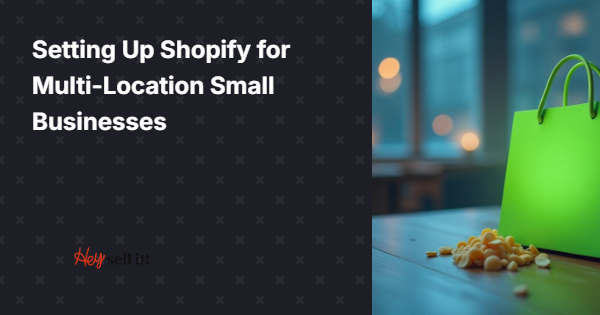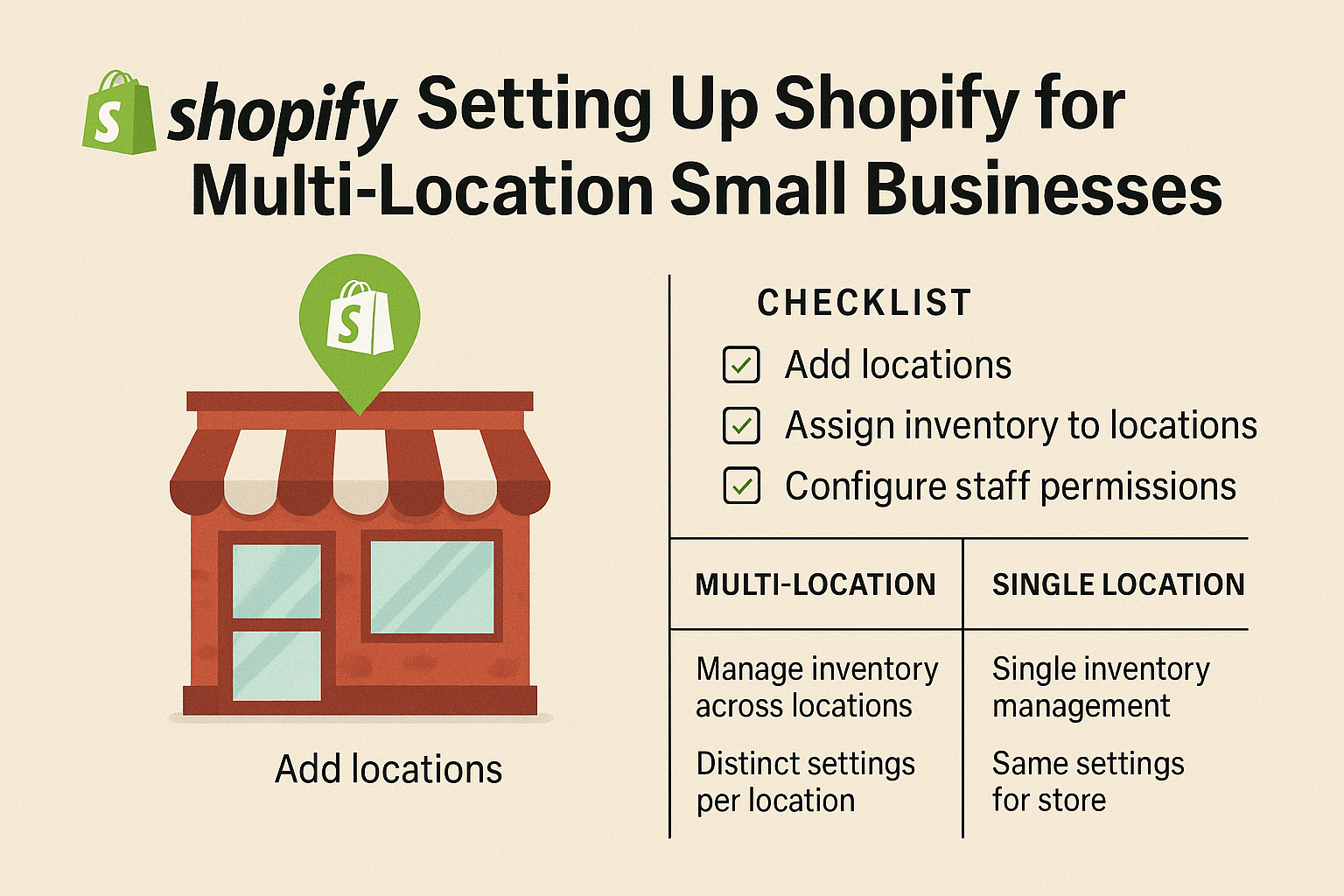Abdullah Usman
Sarah runs a successful boutique clothing store in downtown Chicago. Business is booming, and she’s ready to expand to Milwaukee and Indianapolis. But here’s the challenge – how does she maintain her online presence while serving customers across three different cities without losing her local SEO rankings or confusing her customers?
If you’re a small business owner facing similar expansion challenges, you’re not alone. According to recent industry data, 67% of multi-location businesses struggle with managing their online presence effectively. The good news? Shopify’s multi-location features, when properly configured with strategic SEO services, can transform your expansion from a headache into a competitive advantage.
After working with hundreds of e-commerce businesses over my 8 years in the industry, I’ve seen firsthand how the right multi-location setup can increase local traffic by up to 150% and boost conversion rates by 23%. Let’s dive into exactly how you can achieve these results for your business.
Why Multi-Location Setup Matters More Than You Think
Your customers expect personalized experiences based on their location. When someone in Austin searches for your products, they want to know if you have a local store, what’s in stock nearby, and how quickly they can get their hands on your products. A poorly configured multi-location setup doesn’t just hurt your SEO audit results – it directly impacts your bottom line.
Consider this: businesses with optimized local SEO strategies see 50% more qualified leads compared to those without. When you multiply this across multiple locations, the impact becomes exponential. This is where strategic ecommerce SEO implementation becomes crucial for your success.
What Exactly Is Shopify’s Multi-Location Feature?
Shopify’s multi-location functionality allows you to manage inventory, fulfill orders, and track products across multiple physical locations from a single dashboard. Think of it as having one brain controlling multiple bodies – each location operates independently while remaining connected to your central system.
This feature becomes particularly powerful when combined with proper Shopify SEO techniques. You can create location-specific product availability, customize shipping options, and even adjust pricing based on regional factors. The system tracks inventory in real-time across all locations, preventing overselling and improving customer satisfaction.
How Does Multi-Location Impact Your Local SEO Strategy?
Here’s where many business owners make critical mistakes. They set up multiple locations in Shopify but forget about the local SEO implications. Each location needs its own digital footprint, complete with location-specific content, local keywords, and optimized Google My Business profiles.
When properly implemented, multi-location setups can dramatically improve your semantic SEO performance. Search engines understand the relationship between your locations and can serve more relevant results to users based on their geographic proximity. This creates a powerful network effect where each location strengthens the others’ online visibility.
Step-by-Step Guide: Setting Up Your First Additional Location
Location Creation Process
Start by navigating to your Shopify admin panel and selecting “Settings,” then “Locations.” Click “Add location” and provide detailed information including the exact street address, phone number, and operating hours. This information directly feeds into your local SEO efforts, so accuracy is crucial.
Name your location using a clear, descriptive format like “Hey Sell It – Downtown Miami” rather than generic terms like “Location 2.” This naming convention helps both your team and search engines understand the geographic relevance of each location.
Inventory Assignment Strategy
Once your location is created, you’ll need to assign inventory. This isn’t just about moving products around – it’s about creating location-specific availability that enhances user experience. For example, if your Chicago location specializes in winter gear while your Miami location focuses on beachwear, reflect this in your inventory distribution.
The key is maintaining realistic stock levels at each location while ensuring popular items are available across multiple sites. This strategy supports your on page SEO efforts by creating location-relevant content and product associations.
Which Products Should Be Available at Each Location?
This decision significantly impacts both your operational efficiency and SEO performance. Start by analyzing your sales data to identify location-specific preferences. Urban locations might favor compact, portable products, while suburban stores could focus on family-oriented items.
Consider seasonal variations as well. A ski equipment retailer would stock differently in Colorado versus California locations. This geographic relevance sends strong signals to search engines about your local expertise and helps improve your local SEO rankings.
Create a product matrix that accounts for local demographics, seasonal patterns, and shipping logistics. Products with high local demand should be readily available, while specialty items might be distributed based on historical performance data.
How to Optimize Inventory Management Across Multiple Locations
Effective inventory management prevents stockouts, reduces shipping costs, and improves customer satisfaction – all factors that indirectly boost your SEO performance through improved user experience signals.
Real-Time Inventory Tracking
Shopify’s system updates inventory levels automatically when sales occur at any location. However, you need to establish clear protocols for manual adjustments, transfers between locations, and handling damaged goods. These processes ensure your online inventory always reflects reality, preventing customer disappointment and negative reviews.
Strategic Stock Distribution
Don’t simply divide inventory equally across locations. Use data-driven approaches to determine optimal stock levels. High-performing locations might require 40% more inventory than slower-moving sites. Monitor metrics like inventory turnover rate, stockout frequency, and customer satisfaction scores for each location.
What Are the Best Practices for Location-Specific Shipping?
Shipping strategy directly impacts your conversion rates and customer satisfaction scores – both crucial ranking factors for ecommerce SEO. Customers expect faster delivery from nearby locations, and meeting these expectations can significantly boost your local search rankings.
Zone-Based Shipping Configuration
Create shipping zones that prioritize fulfillment from the nearest location. This reduces delivery times and shipping costs while improving your environmental footprint – a factor increasingly important to modern consumers. Set up automatic routing rules that select the optimal fulfillment location based on customer proximity and product availability.
Local Delivery Options
Offer same-day or next-day delivery within specific radius zones around each location. This premium service justifies higher shipping fees while creating a competitive advantage that’s difficult for online-only competitors to match. Promote these local delivery options prominently on your product pages to improve local conversion rates.
How to Handle Location-Specific Pricing and Promotions
Different markets often support different pricing strategies. Urban locations might bear premium pricing, while competitive suburban markets require more aggressive pricing. Shopify’s multi-location features allow for this flexibility when properly configured.
Dynamic Pricing Strategies
Implement location-based pricing that reflects local market conditions, operating costs, and competitive landscapes. However, ensure transparency in your pricing to maintain customer trust. Significant price differences between nearby locations can create customer confusion and negative reviews.
Targeted Promotional Campaigns
Create location-specific promotions that address local events, seasons, or competitive pressures. A back-to-school promotion might work well near university towns, while beach-related sales make sense for coastal locations. These targeted campaigns improve relevance and boost local engagement metrics.
Why Location Pages Are Crucial for Your SEO Success
Each physical location should have its own dedicated page on your website. These location pages serve as local SEO powerhouses, helping you rank for location-specific searches while providing valuable information to potential customers.
Essential Location Page Elements
Include complete contact information, detailed directions, parking information, store hours, and staff highlights. Add customer testimonials specific to each location and showcase location-specific inventory or services. These elements create unique, valuable content that search engines reward with better rankings.
Local Content Integration
Develop content that connects each location to its local community. Write about local events, partnerships with nearby businesses, or community involvement. This approach strengthens your local SEO signals while building genuine community connections that drive word-of-mouth marketing.
How to Integrate Google My Business with Multiple Locations
Your Google My Business optimization directly impacts your local search visibility. Each location needs its own verified GMB profile with consistent information across all platforms. This consistency signals trustworthiness to search engines and improves your local pack rankings.
Profile Optimization Strategies
Use location-specific phone numbers, post regular updates about each location, and encourage customer reviews for individual sites. Respond to all reviews professionally and promptly – this engagement signals active management to both customers and search engines.
Photo and Content Management
Upload high-quality photos of each location’s exterior, interior, products, and staff. Include photos of local events or community involvement. These visual elements increase engagement and help customers connect with your local presence.
What Common Mistakes Should You Avoid?
Inventory Oversights
The biggest mistake I see is failing to maintain accurate inventory levels across locations. When customers order products that aren’t actually available at their nearest location, it creates fulfillment delays, customer frustration, and negative reviews that hurt your SEO performance.
Inconsistent Business Information
Maintaining consistent NAP (Name, Address, Phone) information across all online platforms is crucial for local SEO. Even small discrepancies can confuse search engines and hurt your local rankings. Create a master spreadsheet tracking all business listings and update them simultaneously when changes occur.
Neglecting Location-Specific Content
Generic content doesn’t serve local SEO goals. Each location needs unique, relevant content that speaks to its specific community and customer base. This includes location-specific product descriptions, local testimonials, and community-focused blog content.
How to Measure Multi-Location Success
Key Performance Indicators
Track location-specific metrics including local search rankings, Google My Business insights, inventory turnover rates, and customer satisfaction scores. These metrics reveal which locations are performing well and which need additional attention.
SEO Performance Monitoring
Monitor local keyword rankings for each location, track organic traffic sources, and analyze conversion rates by geographic region. This data helps you optimize your local SEO strategy and identify expansion opportunities.
Use tools like Google Analytics to set up location-specific goals and funnels. This granular tracking reveals how different locations contribute to your overall business objectives and helps guide resource allocation decisions.
Action Steps: Your Multi-Location Implementation Checklist
- Audit Your Current Setup: Conduct a comprehensive SEO audit of your existing Shopify store to identify optimization opportunities before adding complexity.
- Plan Your Location Strategy: Define clear objectives for each location, including target markets, product focus, and local SEO goals.
- Configure Shopify Locations: Set up each location with accurate information, appropriate inventory levels, and optimized settings.
- Create Location Pages: Develop comprehensive location pages with unique, valuable content for each site.
- Optimize Google My Business: Create and verify GMB profiles for each location with consistent, accurate information.
- Implement Tracking: Set up analytics and monitoring systems to track performance across all locations.
- Launch and Monitor: Go live with your multi-location setup and closely monitor performance metrics for optimization opportunities.
Ready to Dominate Multiple Markets?
Setting up Shopify for multiple locations isn’t just about operational efficiency – it’s about creating a local SEO powerhouse that drives qualified traffic and increases conversions across all your markets. When done correctly, this strategy can transform your business from a single-location operation into a regional authority that competitors struggle to match.
The businesses that succeed with multi-location strategies are those that treat each location as a unique entity while maintaining brand consistency and operational excellence. By following the strategies outlined in this guide, you’re positioning your business for sustainable growth and local market dominance.
Remember, successful multi-location setup requires ongoing optimization and monitoring. As your business grows and markets evolve, your strategy should adapt accordingly. The investment in proper setup and ongoing management pays dividends through increased visibility, higher conversion rates, and stronger local market position.
Your expansion journey starts with a single additional location. Take the first step today, and begin building the multi-location empire your business deserves.


